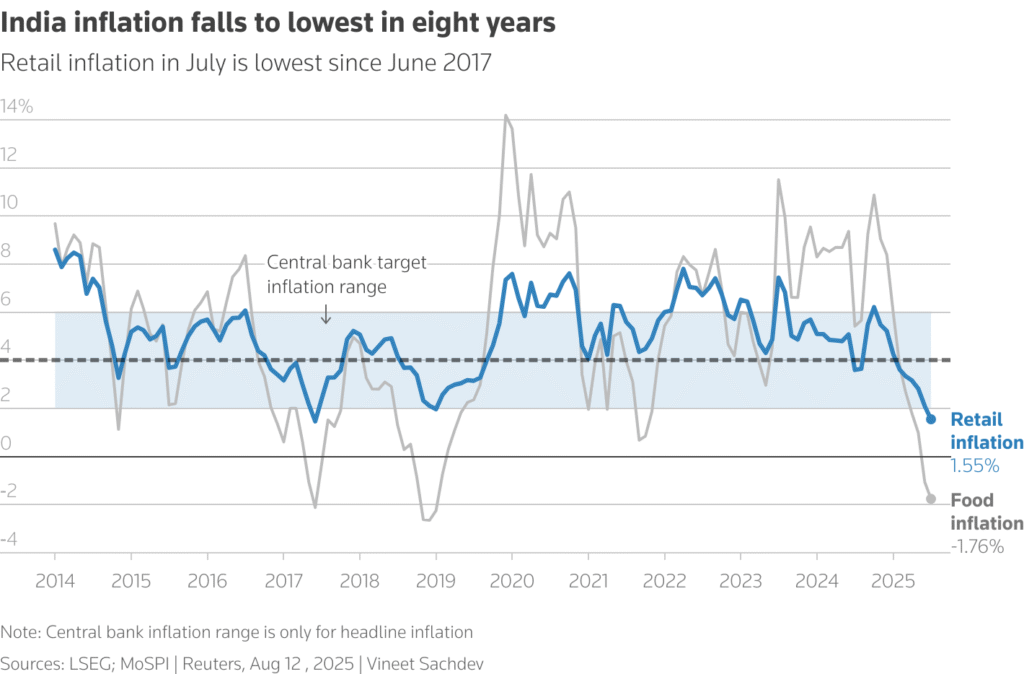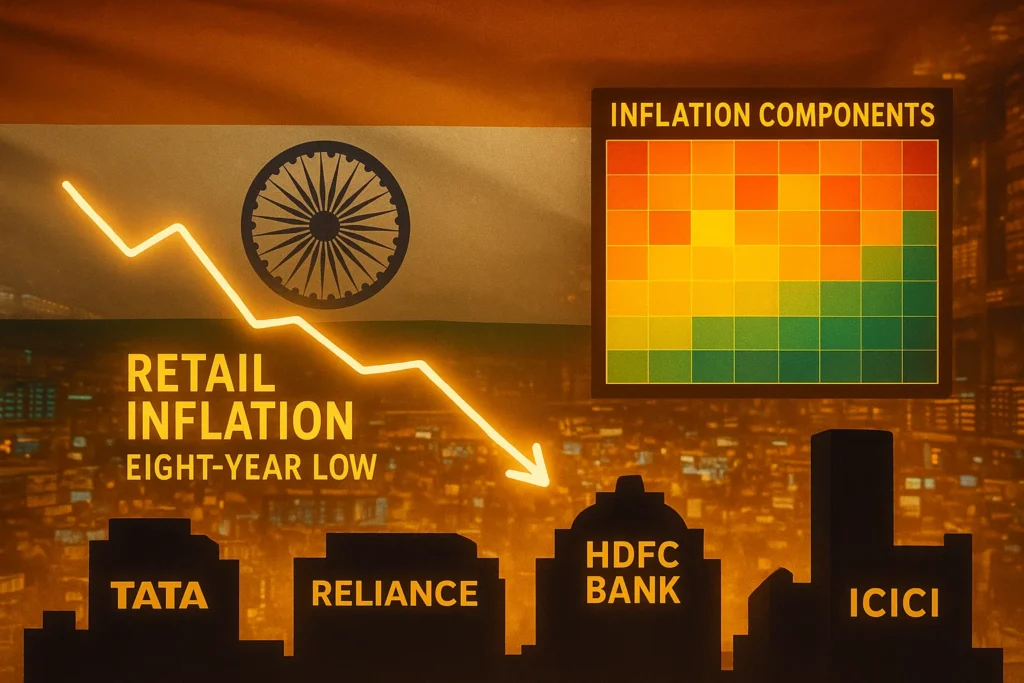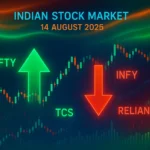Introduction
If you follow the markets, you know some numbers can move more than just charts — they can shift the mood. The India inflation July 2025 number is one of those. At 1.55%, inflation has dropped to its lowest level since June 2017.
It’s not just a statistical footnote. This is the first time in more than six years that inflation has fallen below the Reserve Bank of India’s official comfort zone of 2–6%. And while the headlines celebrate cheaper vegetables and pulses, the deeper story touches everything — from farm incomes to rate cuts, from rural demand to stock market plays.
So, let’s unpack what this number means, why it matters, and where the market might head next.
India Inflation July 2025 Hits Record Low — What It Means
Inflation is like the economy’s heartbeat. Too fast, and it strains purchasing power. Too slow, and it can signal weak demand.
In July 2025, retail inflation eased to 1.55%, down from 2.10% in June. For context, this number is not just low — it’s the lowest in eight years. And it’s happened because food prices have been on a steep downhill run.
Here’s the quick picture:
| Indicator | July 2025 | June 2025 | Change |
|---|---|---|---|
| Retail Inflation | 1.55% | 2.10% | ▼ 0.55% |
| Food Inflation | -1.76% | -1.01% | ▼ 0.75% |
| Vegetable Prices | -20.69% | -19.00% | ▼ 1.69% |
| Pulses Prices | -13.76% | -12.00% | ▼ 1.76% |
| Core Inflation | 4.00% – 4.12% | 4.40% – 4.50% | ▼ ~0.40% |

The line chart above shows how India’s retail and food inflation have moved over the last year, highlighting the steep fall in July 2025. Retail inflation’s drop to 1.55% marks its lowest level in eight years.
Seeing the trend visually makes it clear — this is not just a one-month blip but the continuation of a softening price trend, largely driven by food.
India Inflation July 2025: Impact on Everyday Consumers
Numbers are one thing, but the story behind India inflation July 2025 is layered.
- Vegetable Prices: Down 20.69% year-on-year, a bigger drop than June’s 19%.
- Pulses Prices: Fell 13.76% in July versus 12% in June.
- Month-on-Month Moves: Some vegetables like tomatoes saw prices bounce slightly in July, hinting at a possible short-term reversal.
For consumers, this is good news. Cheaper vegetables and pulses leave more room in household budgets. But for farmers, it’s a different reality. Lower selling prices can shrink incomes, which may reduce spending in rural areas — an important demand engine for India’s economy.

The heat map above compares the inflation rates of various components of India’s retail inflation basket. The color coding against the RBI’s 2–6% target range makes it clear which segments are pulling the overall rate below the comfort band.
The heat map tells a revealing story — most food categories are well below target, dragging the headline number down, while non-food categories like housing and core items remain relatively stable.
RBI Policy Signals Following India Inflation July 2025
The Reserve Bank of India has one key inflation mandate: keep it between 2% and 6%. If it goes outside this band for three consecutive quarters, the RBI must explain why.
Now, with India inflation July 2025 at 1.55%, we’ve dipped below the band for the first time since January 2019. Does this mean an emergency rate cut? Not right away.
Here’s why:
- The RBI already lowered its FY25 inflation forecast to 3.1% from 3.7% in its last meeting.
- It kept interest rates unchanged, confident about India’s growth prospects.
- Policymakers see the July dip as temporary, driven by volatile food prices.
In short, while rate cuts are back on the table for the coming quarters, the RBI isn’t in a hurry yet.
The Tariff Twist — An External Shock
Just as the inflation data came out, another curveball hit the economy. U.S. President Donald Trump announced an additional 25% tariff on Indian goods. That takes duties to 50% on about 55% of India’s exports to the U.S.
The impact?
- Export-heavy sectors like textiles, engineering, and chemicals could see lower orders.
- Economists estimate a 30–40 basis point hit to GDP growth.
- If combined with low inflation, this could push the RBI toward easing rates sooner than expected.
So now, the market isn’t just watching domestic inflation — it’s also keeping an eye on global trade politics.
How the Stock Market Reads the Inflation Story
When inflation changes direction, the market starts rearranging its priorities. For India inflation July 2025, here’s how sentiment could shape up:
Positive Triggers
- Rate Cut Potential: Lower inflation gives the RBI room to ease policy rates, which can lift sentiment in banking, NBFC, and housing sectors.
- Boost to Consumer Spending: Cheaper essentials mean more money for discretionary purchases. That’s a win for FMCG and retail.
Areas of Caution
- Rural Income Stress: Lower farm prices could slow demand for two-wheelers, tractors, and rural FMCG sales.
- Export Risks: Tariffs could cut into margins for companies dependent on the U.S. market.
Sector-Wise Market Impact
Different sectors react differently to falling inflation. Here’s a sector view based on the July data:
| Sector | Short-Term View | Reason |
|---|---|---|
| FMCG | Positive | More purchasing power could lift volumes. |
| Banking & NBFCs | Positive | Rate cut hopes could boost lending activity. |
| Autos | Positive | Lower EMIs and better consumer sentiment. |
| Exporters | Caution | U.S. tariffs may hurt revenue streams. |
| Agriculture-linked | Mixed | Lower crop prices hurt incomes but good sowing could offset. |
Top 5 Stocks to Watch in Light of India Inflation July 2025
With inflation cooling to 1.55% in July 2025, markets are tilting toward sectors sensitive to interest rates and consumption. Below are five best-in-class stocks to keep an eye on—each positioned to benefit as macro tailwinds shift.
1. HDFC Bank (Large Cap)
First, HDFC Bank stands out thanks to its robust deposit franchise and diversified loan book. As inflation retreats, funding costs ease, boosting net interest margins. Furthermore, improving consumer sentiment is likely to fuel retail loan demand.
2. Maruti Suzuki (Large Cap)
Next, Maruti Suzuki is well-placed for a revival in auto demand. With lower EMIs and a stable inflation backdrop, affordable car sales could surge. Moreover, its strong urban and semi-urban reach gives it an edge during consumer spending recoveries.
3. Bajaj Finance (Mid Cap)
Then, look at Bajaj Finance—an NBFC powerhouse. Lower inflation helps reduce its cost of funds while reviving demand for consumer loans. Importantly, its wide product suite and strong collection discipline make it one of the most resilient mid caps.
4. Titan Company (Mid Cap)
Meanwhile, Titan Company—a consumer durables and jewelry leader—can benefit from increased discretionary spending. As essentials become cheaper, consumers often shift spend toward aspirational goods. Therefore, Titan’s premium positioning makes it a compelling pick.
5. Ujjivan Small Finance Bank (Small Cap)
Finally, for those seeking small-cap exposure, Ujjivan SFB offers an interesting play. It focuses on lower-income rural and semi-urban borrowers. While rural inflation headwinds persist, improving wage growth and lower food costs can gradually ease stress and boost credit uptake.
Summary Table
| Stock | Sector | Key Benefit |
|---|---|---|
| HDFC Bank | Banking | Margins improve + loan growth |
| Maruti Suzuki | Autos | EMIs fall, demand revival |
| Bajaj Finance | NBFC | Funding cost cuts + demand |
| Titan Company | Consumer | Discretionary demand pick-up |
| Ujjivan SFB | Small Finance | Rural credit growth potential |
In summary, these five names span large, mid, and small caps—each selected for its ability to leverage the India inflation July 2025 environment. From banks to consumer brands, they present a balanced watchlist anchored in the shifting macro current.
Why This Inflation Drop Feels Different
Not every low-inflation moment makes waves. But India inflation July 2025 has a unique mix of triggers:
- It’s the lowest in eight years.
- It’s below RBI’s comfort zone for the first time in over six years.
- It coincides with a major global trade development — the U.S. tariffs.
That combination means markets have to weigh domestic optimism against external uncertainty.
Short-Term Market Mood
In the short term, the markets may cheer the possibility of lower rates. Banking, NBFCs, autos, and consumer stocks could get some lift.
However, this could be tempered if August inflation climbs back to the expected 2.1%. That would still be low, but enough to cool the rate cut buzz.
The Longer Play for Investors
For long-term investors, the message from India inflation July 2025 is clear — economic cycles turn fast. The same falling food prices that are bringing joy to consumers today could reverse quickly with weather shocks or supply chain issues.
That’s why it pays to:
- Track core inflation trends, not just headline numbers.
- Watch rural wage data and crop arrival patterns.
- Follow RBI commentary for policy signals.
- Monitor global trade developments that can alter export competitiveness.
Final Word — Balancing the Optimism
The sharp fall in India inflation July 2025 is good news for urban consumers and a potential green light for rate cuts. It offers the market a short-term sentiment boost and could make the festive season stronger for demand-heavy sectors.
But rural distress, export pressures, and volatile food prices remind us that the picture isn’t all green. Investors would do well to balance optimism with selective positioning — tilting toward rate-sensitive and consumer sectors, while being cautious on exporters until the tariff dust settles.
If the inflation trend holds and the RBI opens the rate cut tap, the coming quarters could see a rally in interest-rate-sensitive names. Until then, July’s record-low inflation remains a milestone worth noting — and a market signal worth watching closely.
FAQs – India Inflation July 2025
1. What is India inflation July 2025 rate?
India’s retail inflation in July 2025 was 1.55%, the lowest in eight years.
2. Why is India inflation July 2025 considered historic?
Because it fell below 2% for the first time in almost a decade.
3. What caused the drop in India inflation July 2025?
Lower vegetable and pulses prices, along with steady fuel rates, drove the decline.
4. How does India inflation July 2025 affect common people?
It means slower price growth, giving consumers relief in daily expenses.
5. Did RBI influence India inflation July 2025?
Yes, earlier interest rate policies helped cool demand and control prices.
6. Which sectors saw the biggest drop in India inflation July 2025?
Vegetables, pulses, and cereals saw the sharpest decline.
7. Will India inflation July 2025 impact interest rates?
It could prompt the RBI to consider rate cuts in future policy meetings.
8. How does India inflation July 2025 compare globally?
India’s inflation is now among the lowest in major economies.
9. Is India inflation July 2025 good for the stock market?
Lower inflation often boosts investor confidence, benefiting equities.
10. Where can I track India inflation after July 2025?
You can check monthly updates from the Ministry of Statistics and RBI reports.
Related Articles:
WPI Inflation Falls Below Zero: What It Means for Markets, Sectors & Stocks
Retail Inflation Crashes to 2.10% in June 2025: What It Means for Consumers, RBI & Stocks
Medical Inflation: Stocks That Gain & Lose
How Inflation Affects the Stock Market: Why April’s Cooldown Is a Gamechanger
More Articles
India’s Future Outlook: Growth vs Inflation
India Eyes Japan’s $35 Billion Apparel Market: CEPA Boost, PLI Push & Stocks to Watch
How RBI’s Gold Loan LTV Hike Impacts Small Borrowers and NBFCs






